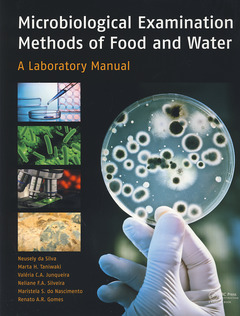Microbiological Examination Methods of Food and Water A Laboratory Manual
Auteurs : da Silva Neusely, Hirotomi Taniwaki Marta, Junqueira Valéria Christina, Silveira Neliane, do Nascimento Maristela da Silva, Romeiro Gomes Renato Abeilar

Microbiological Examination Methods of Food and Water is an illustrated laboratory manual that provides an overview of current standard microbiological culture methods for the examination of food and water, adhered to by renowned international organizations, such as ISO, AOAC, APHA, FDA and FSIS/USDA. It includes methods for the enumeration of indicator microorganisms of general contamination, indicators of hygiene and sanitary conditions, sporeforming, spoilage fungi and pathogenic bacteria.
Every chapter begins with a comprehensive, in-depth and updated bibliographic reference on the microorganism(s) dealt with in that particular section of the book. The latest facts on the taxonomic position of each group, genus or species are given, as well as clear guidelines on how to deal with changes in nomenclature on the internet. All chapters provide schematic comparisons between the methods presented, highlighting the main differences and similarities. This allows the user to choose the method that best meets his/her needs. Moreover, each chapter lists validated alternative quick methods, which, though not described in the book, may and can be used for the analysis of the microorganism(s) dealt with in that particular chapter. The didactic setup and the visualization of procedures in step-by-step schemes allow the user to quickly perceive and execute the procedure intended.
This compendium will serve as an up-to-date practical companion for laboratory professionals, technicians and research scientists, instructors, teachers and food and water analysts. Alimentary engineering, chemistry, biotechnology and biology (under)graduate students specializing in food sciences will also find the book beneficial. It is furthermore suited for use as a practical/laboratory manual for graduate courses in Food Engineering and Food Microbiology.
1. Collection, transportation and storage of samples for analysis 2. Preparation of samples for analysis 3. Basic plate count techniques for the enumeration of microorganisms 4. Basic techniques for microbial enumeration by the Most Probable Number method 5. Basic techniques for the detection of presence/absence of microorganisms 6. Total plate counts of aerobic mesophilic and psychrotrophic microorganisms 7. Yeast and mold counts 8. Enterobacteria counts 9. Total coliforms, thermotolerant coliforms and Escherichia coli counts 10. Staphylococcus aureus 11. Bacillus cereus 12. Sulphite-reducing clostridia and Clostridium perfringens 13. Enterococci counts 14 Lactic bacteria counts 15. Campylobacter 16. Cronobacter 17. Escherichia coli O157:H7 18. Listeria monocytogenes 19. Salmonella 20. Pathogenic vibrios 21. Yersinia enterocolitica 22. Bacterial spore counts 23. Commercial sterility or cause of spoilage 24. Pseudomonas spp 25. Preparation of laboratory materials for microbiological analyses 26. Care in the preparation of culture media and reagents for microbiological analyses Annex 1. Preparation of media and reagents for analysis Annex 2: 2A. Technical regulation on microbiological standards for foods) 2B. Technical Regulation on the microbiological characteristics of natural mineral water and natural water 2C. Control and surveillance of water intended for human consumption and its drinking quality standard) Annex 3. Factors affecting microbial growth in foods
Date de parution : 12-2012
Ouvrage de 456 p.
21x28 cm
Thèmes de Microbiological Examination Methods of Food and Water :
Mots-clés :
Method APHA; AOAC Official Method; Butterfield’s Phosphate Buffer; Absence Method; 1ml 1ml 1ml 1ml 1ml; PW; Total Aerobic Mesophilic Counts; 1ml 1ml 1ml 1ml; 1ml 1ml; 10ml 10ml 10ml; Differential Agent; BPW; Pour Plating; Target Microorganism; MPN Table; Pre-enrichment Broth; Lactic Acid Bacterium; GRAM STAINING; Acetyl Methyl Carbinol; Acetoin; AOAC International; Arginine Dihydrolase; Heat Resistant Molds; Agar Plug; TSB



